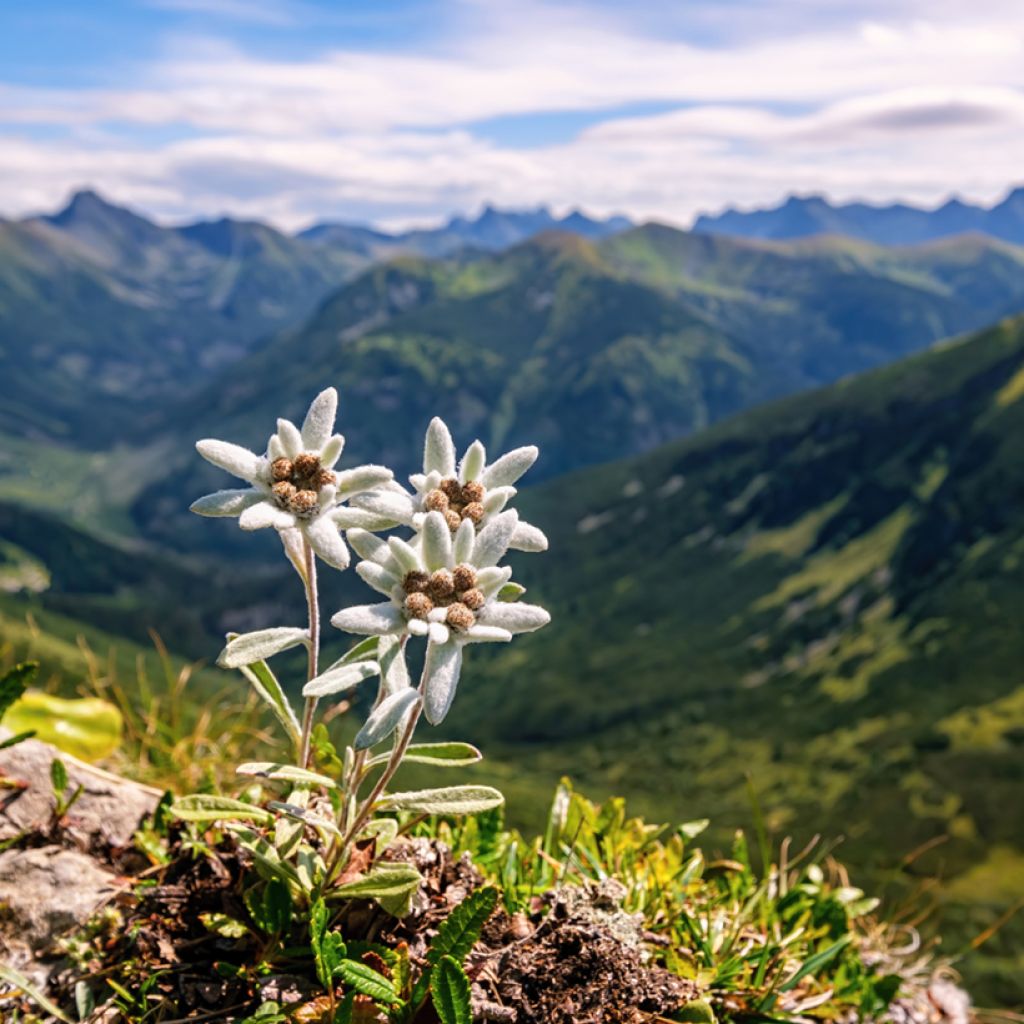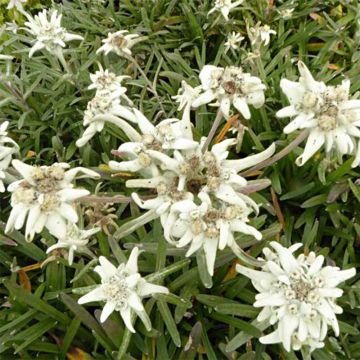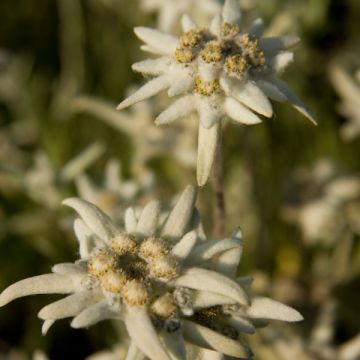

Edelweiss Seeds - Leontopodium alpinum
Edelweiss Seeds - Leontopodium alpinum
Leontopodium alpinum
Edelweiss, Alpine edelweiss
No seed has taken. I am disappointed. Yours sincerely
Pierre, 19/11/2023
Special offer!
Receive a €20 voucher for any order over €90 (excluding delivery costs, credit notes, and plastic-free options)!
1- Add your favorite plants to your cart.
2- Once you have reached €90, confirm your order (you can even choose the delivery date!).
3- As soon as your order is shipped, you will receive an email containing your voucher code, valid for 3 months (90 days).
Your voucher is unique and can only be used once, for any order with a minimum value of €20, excluding delivery costs.
Can be combined with other current offers, non-divisible and non-refundable.
Home or relay delivery (depending on size and destination)
Schedule delivery date,
and select date in basket
This plant carries a 6 months recovery warranty
More information
We guarantee the quality of our plants for a full growing cycle, and will replace at our expense any plant that fails to recover under normal climatic and planting conditions.
Would this plant suit my garden?
Set up your Plantfit profile →
Description
Edelweiss is an iconic alpine perennial. In spring or early summer, it displays star-shaped flower heads, made up of discreet creamy yellow flowers and fuzzy, silvery white bracts. Its dark green lanceolate foliage is also covered with a protective woolly down. A gem for rock gardens in cool, mountainous climates. Fairly easy to grow from seed in very well-drained soil, in full sun or partial shade.
Leontopodium alpinum or Edelweiss is a small perennial plant belonging to the Asteraceae family. It is native to the Alps, of which it has become the symbol. It forms small mounds of evergreen foliage, growing to about 15 to 20 cm in height for a spread of about 15 cm. To protect itself from ultraviolet rays, which are intense at high altitudes, but also from freezing temperatures, both foliage and flower bracts are covered with woolly hairs. The flowers are tiny and creamy yellow in colour. They are mainly pollinated by flies as the nectar is rich in essential amino acids.
Edelweiss a truly symbolic plant, offering an unforgettable display of soft, silvery-white blooms from May to July. It thrives in cool climates in perfectly drained, rocky, limestone soil, in full sun or part shade. It combines well with other mountain plants such as Campanula portenschlagiana, Aethionema x Warley Rose, Azorella trifurcata, Cyclamen coum, Globularia cordifolia and perennial Geranium cinereum.
Good to know: Edelweiss was traditionally used to soothe stomach pains, sore throats, bronchitis and diarrhoea or dysentery. Nowadays, it is used in cosmetics for its powerful antioxidant properties.
Report an error about the product description
Flowering
Foliage
Plant habit
Botanical data
Leontopodium
alpinum
Asteraceae
Edelweiss, Alpine edelweiss
Alps
Other Edelweiss - Leontopodium
View all →Planting and care
Edelweiss is protected in the wild. It is easy to propagate using mature seeds, from March to June. It can then be planted out in rock gardens, in full sun (part-shade in warmer climates). It dreads waterlogged soil, make to provide the plants with excellent drainage.
Use a small pot, about 10 cm deep. Make sure that the bottom of the pot has a few holes in it to enable water drainage. Add 1 or 2 cm of gravel at the bottom of the pot. Mix equal parts of sand and leafy, humus-rich soil. Fill the pot and firm it down, so that the surface of the soil is 1 cm below the rim. Use a handheld seeder to spread the seeds evenly over the entire surface of the substrate. Cover with a very thin layer of sieved soil mix and firm down again. Water with a hand sprayer to avoid uncovering or moving the seeds. Place the pot in a cold frame, in a bright spot but away from intense sunlight, and ventilate during the hottest hours of the day. Keep the soil moist until germination (about 21 days).
Alternatively, imitate the plants’ natural growing cycle by placing the pot in the freezer for a week. Then move the seedlings to a cold frame at a temperature of 18-22ºC. Thin out and transplant as soon as the seedlings are strong enough to handle.
Sowing period
Intended location
Planting & care advice
-
, onOrder confirmed
Reply from on Promesse de fleurs
Haven't found what you were looking for?
Hardiness is the lowest winter temperature a plant can endure without suffering serious damage or even dying. However, hardiness is affected by location (a sheltered area, such as a patio), protection (winter cover) and soil type (hardiness is improved by well-drained soil).

Photo Sharing Terms & Conditions
In order to encourage gardeners to interact and share their experiences, Promesse de fleurs offers various media enabling content to be uploaded onto its Site - in particular via the ‘Photo sharing’ module.
The User agrees to refrain from:
- Posting any content that is illegal, prejudicial, insulting, racist, inciteful to hatred, revisionist, contrary to public decency, that infringes on privacy or on the privacy rights of third parties, in particular the publicity rights of persons and goods, intellectual property rights, or the right to privacy.
- Submitting content on behalf of a third party;
- Impersonate the identity of a third party and/or publish any personal information about a third party;
In general, the User undertakes to refrain from any unethical behaviour.
All Content (in particular text, comments, files, images, photos, videos, creative works, etc.), which may be subject to property or intellectual property rights, image or other private rights, shall remain the property of the User, subject to the limited rights granted by the terms of the licence granted by Promesse de fleurs as stated below. Users are at liberty to publish or not to publish such Content on the Site, notably via the ‘Photo Sharing’ facility, and accept that this Content shall be made public and freely accessible, notably on the Internet.
Users further acknowledge, undertake to have ,and guarantee that they hold all necessary rights and permissions to publish such material on the Site, in particular with regard to the legislation in force pertaining to any privacy, property, intellectual property, image, or contractual rights, or rights of any other nature. By publishing such Content on the Site, Users acknowledge accepting full liability as publishers of the Content within the meaning of the law, and grant Promesse de fleurs, free of charge, an inclusive, worldwide licence for the said Content for the entire duration of its publication, including all reproduction, representation, up/downloading, displaying, performing, transmission, and storage rights.
Users also grant permission for their name to be linked to the Content and accept that this link may not always be made available.
By engaging in posting material, Users consent to their Content becoming automatically accessible on the Internet, in particular on other sites and/or blogs and/or web pages of the Promesse de fleurs site, including in particular social pages and the Promesse de fleurs catalogue.
Users may secure the removal of entrusted content free of charge by issuing a simple request via our contact form.
The flowering period indicated on our website applies to countries and regions located in USDA zone 8 (France, the United Kingdom, Ireland, the Netherlands, etc.)
It will vary according to where you live:
- In zones 9 to 10 (Italy, Spain, Greece, etc.), flowering will occur about 2 to 4 weeks earlier.
- In zones 6 to 7 (Germany, Poland, Slovenia, and lower mountainous regions), flowering will be delayed by 2 to 3 weeks.
- In zone 5 (Central Europe, Scandinavia), blooming will be delayed by 3 to 5 weeks.
In temperate climates, pruning of spring-flowering shrubs (forsythia, spireas, etc.) should be done just after flowering.
Pruning of summer-flowering shrubs (Indian Lilac, Perovskia, etc.) can be done in winter or spring.
In cold regions as well as with frost-sensitive plants, avoid pruning too early when severe frosts may still occur.
The planting period indicated on our website applies to countries and regions located in USDA zone 8 (France, United Kingdom, Ireland, Netherlands).
It will vary according to where you live:
- In Mediterranean zones (Marseille, Madrid, Milan, etc.), autumn and winter are the best planting periods.
- In continental zones (Strasbourg, Munich, Vienna, etc.), delay planting by 2 to 3 weeks in spring and bring it forward by 2 to 4 weeks in autumn.
- In mountainous regions (the Alps, Pyrenees, Carpathians, etc.), it is best to plant in late spring (May-June) or late summer (August-September).
The harvesting period indicated on our website applies to countries and regions in USDA zone 8 (France, England, Ireland, the Netherlands).
In colder areas (Scandinavia, Poland, Austria...) fruit and vegetable harvests are likely to be delayed by 3-4 weeks.
In warmer areas (Italy, Spain, Greece, etc.), harvesting will probably take place earlier, depending on weather conditions.
The sowing periods indicated on our website apply to countries and regions within USDA Zone 8 (France, UK, Ireland, Netherlands).
In colder areas (Scandinavia, Poland, Austria...), delay any outdoor sowing by 3-4 weeks, or sow under glass.
In warmer climes (Italy, Spain, Greece, etc.), bring outdoor sowing forward by a few weeks.












































